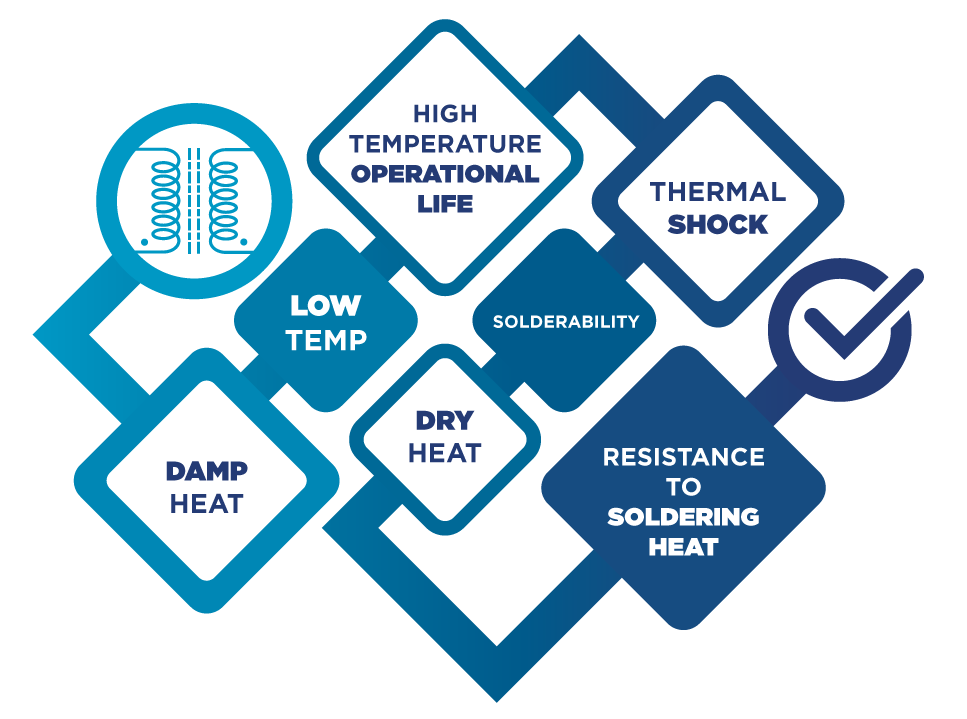To ensure consistent performance and durability across a range of operating conditions, our inductors and transformers are being evaluated using the ICE Reliability Test Standard — a rigorous internal benchmark developed to simulate real-world environmental and assembly stresses. Each test is designed to validate mechanical integrity, thermal resilience, and electrical stability under demanding scenarios.
| No. | Item | Test Condition | Criteria | Qty |
|---|---|---|---|---|
| 1 | Dry Heat Test | Humidity: Less than 50 % R.H. Temperature*: Temp A ± 5 °C Duration: 96 Hours |
Meets electrical specifications and No physical damage |
5 |
| 2 | Low Temp Test | Temperature: -40 ± 3 °C Duration: 96 Hours |
Meets electrical specifications and No physical damage |
5 |
| 3 | Damp Heat Test | Humidity: 95 (+2 / -3) % R.H. Temperature: 60 ± 2 °C Duration: 96 Hours |
Meets electrical specifications and No physical damage |
5 |
| 4 | High Temp Operational Life | Max Specified Operating Temperature @ Max Rated Power (shall not exceed Temp A)* Duration: 96 Hours |
Meets electrical specifications and No physical damage |
5 |
| 5 | Thermal Shock | Low Temperature: -40 °C High Temperature*: +Temp A Soak Time: 30 Minutes Transition: Less than 5 Minutes Number of Cycles: 100 |
Meets electrical specifications and No physical damage |
5 |
| 6 | Solderability | Solder Bath Temperature: 245+5 °C Duration: 5+0.5 sec |
Solder coverage should exceed 95% | 5 |
| 7a | Resistance to Soldering Heat (THT) | Solder Bath Temperature: 380+10 °C Immersion Duration: 5+0.5 sec |
Meets electrical specifications and No physical damage |
5 |
| 7b | Resistance to Soldering Heat (SMT) | Method: IR Reflow Pre-heat Temp.: 150 °C; Duration: 120 sec min Temperature Above 217 °C; Duration: 60 ~150 sec Peak Temp.: 260 + 5 °C; Duration: 20 sec Number of Cycles: 3 |
Meets electrical specifications and No physical damage |
5 |
| *Temp A: Class B = 130 °C; Class F = 155 °C | ||||
Environmental & Soldering Reliability
A series of stress tests were performed to assess product reliability under harsh environmental conditions. Dry Heat, Low Temperature, and Damp Heat tests simulated extended exposure to high temperatures, freezing conditions, and humid environments — typical of sealed enclosures, outdoor installations, and poorly ventilated spaces. Each test ran for 96 hours under controlled conditions. All samples maintained structural integrity and stable electrical performance, with no visible damage or measurable drift, confirming resistance to passive thermal and moisture stress.
High Temperature Operational Life testing validated consistent electrical output under continuous load at elevated temperatures; additionally, Thermal Shock testing involved 100 rapid cycles between −40 °C and +125 °C, confirming mechanical resilience to thermal expansion and contraction.
Solderability and Resistance to Soldering Heat tests demonstrated strong wetting behavior and heat tolerance during assembly. All units met or exceeded coverage requirements, with no signs of cracking, delamination, or performance degradation. These results support compatibility with automated soldering processes and suitability for high-reliability applications.
Customer-Requested Reliability Tests
Additional reliability tests were performed on select parts per customer request, supplementing the ICE Reliability Standard. Each test follows established industry standards and evaluates electrical performance and physical integrity. Tested components include CT02, CT06, CT10, GT03, GT06, GT07, ISB, and ISE. All parts met the specified criteria across the following assessments:
| Test | Reference Method | Criteria | Tested Parts |
|---|---|---|---|
| Terminal Strength | MIL-STD-202 Method 211 (TH); AEC-Q200-006 (SMD) |
Meets electrical specifications and No physical damage |
CT02, CT06, CT10, GT03, GT06, GT07, and ISE |
| Resistance To Solvent | MIL-STD-202 Method 215 | Meets electrical specifications and No physical damage |
CT02, CT06, CT10, GT03, GT06, GT07, and ISE |
| Mechanical Shock | MIL-STD-202 Method 213 | Meets electrical specifications and No physical damage |
CT02, CT06, CT10, GT03, GT06, GT07, ISB, and ISE |
| Vibration | MIL-STD-202 Method 204 | Meets electrical specifications and No physical damage |
CT02, CT06, CT10, GT03, GT06, GT07, ISB, and ISE |
| Resistance to Soldering Heat | MIL-STD-202 Method 210 | Meets electrical specifications and No physical damage |
CT02, CT06, CT10, GT03, GT06, GT07, and ISE |
| Electrostatic Discharge (ESD) | AEC-Q200-002 & ISO/DIS 10605 | Meets electrical specifications and No physical damage |
CT02, CT06, CT10, GT03, GT06, GT07, ISB, and ISE |
| Board Flex | AEC-Q200-005 | Meets electrical specifications and No physical damage |
CT02, CT06, GT03, GT06, and GT07 |
| Flammability | UL-94 | V-0 or V-1 | CT02, CT06, CT10, GT03, GT06, and GT07 |



